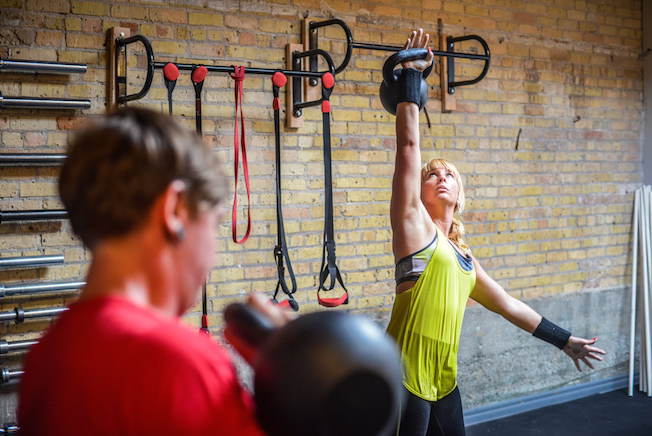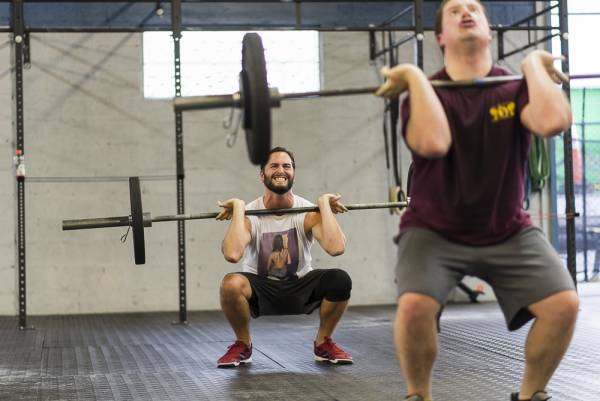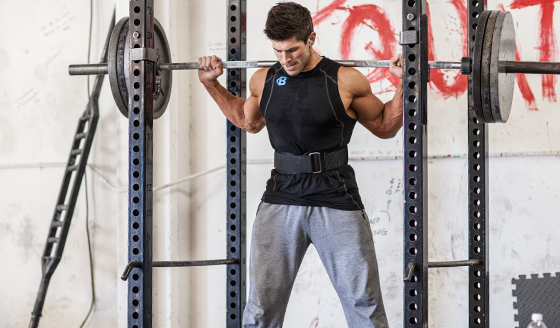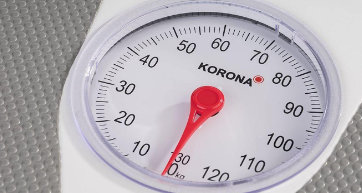Know the effects of training at high repetitions on your strength and hypertrophy
In today's post, we would like to comment on a study conducted on the effects of training at high repetitions when it comes to gaining strength or muscle volume . A group of researchers wanted to study the impact of light weight , high repetition training on gains in functionality and muscle mass. They conducted a study to compare adaptive changes in muscle volume , contractile strength , and fiber types as a result of training both low and high repetitions while maintaining full volume of work.
Lots of weight or lots of reps? Specifically, the research compared 10 sets x 36 repetitions using 15.5% of the 1 RM with 10 sets x 8 repetitions using 70% of the 1 RM. The program lasted 12 weeks, with 3 training sessions in each.
Do you want to know how was the 10 x 8 program? It produced a 7.6% gain in muscle mass ( "hypertrophy" ) and a 35% gain in strength over 1 RM (one repetition maximum).
Not bad, right? And it's not surprising, since training with heavy weight and low repetitions is the commonly accepted way to gain strength and muscle volume.

What about the 10 x 36 program...? Many will argue that training in such a high rep range would improve endurance and either lead to a loss of strength and hypertrophy , or at best these would stay the same but neither our strength nor our size would increase. Remember that popular theory tells us that doing more than 20 reps is "endurance" and that resistance training does not improve strength or muscle hypertrophy. In many bodybuilding and fitness forums , you will read statements such as "When you go past 20, you're training for high reps, and it's not good for strength gains . "
High rep strength training
Anyone who is convinced that high reps in the gym are good for endurance could be wrong.
The 10 x 36 program resulted in a 19% increase in strength over 1RM and a 2.6% gain in muscle size . That's pretty impressive for something many would describe as "resistance training."
What is the use of a lot of weight and few repetitions? There are a couple of things that should be noted from this investigation. First of all, the study clearly shows that a program consisting exclusively of training heavy and low reps produces greater gains in both strength and size than a program that trains exclusively with light weight and higher reps. It is not surprising. Research over the past 80 years has consistently shown this.
But things go further than simply saying "heavy weight and low reps is what counts." The most important point to consider is that "high" reps increased strength levels by 19% and muscle volume by 2.6%. This leads us to two questions. Has this been the only study that has shown that "high" reps produce benefits for strength and hypertrophy with light weight ? And from a physiological starting point… how does high reps increase strength and muscle hypertrophy?

Hypertrophy and strength range
The truth is that there have been multiple studies that have compared changes in strength and hypertrophy from different rep ranges and, despite what conventional theory says, such research has consistently shown that high reps cause increases in both strength and hypertrophy. as in muscle size. Yes, it is true that heavy weights and low repetitions are what increase the strength and volume of the muscles the most. But this doesn't mean higher reps aren't also good for building strength and muscle. It's just that conventional theory has incorrectly interpreted that "heavy weight and low reps builds strength; low weight and high reps improves endurance." The takeaway from this research is that, in fact, " low weight and high reps do increase strength , just not as much as lower rep ranges."
It should be noted from the research that the higher the rep range, the smaller the gain in strength and size. So while a range of 25-35 can build a significant amount of strength, the further you get from these numbers, the smaller your increases in strength will be.
It is undisputed that a heavy weight , low rep training program builds significantly more strength and volume than a lower weight, high rep program. So if you're thinking of training in a dedicated rep range, then go for less than 20. However, the study certainly showed that the idea of conventional strength training could be somewhat inaccurate. High reps increase muscle strength and size. Thus, they are a valid hypertrophy range .


This brings us to the second question. What logical explanation would exist for these results? What is the physiological mechanism by which high reps work to hypertrophy and build strength?
Conclusion on low weight high repetitions in the gym to gain strength
The most logical answer is that, within the conventional "high" reps and "endurance" approach, those reps would not be particularly "high" or really for "endurance." It seems that the relationship between "high" reps and "endurance" gain starts somewhere beyond 20 reps. Exercise is not something that suddenly transforms from "strength" to "endurance" for a few reps. Going from 12 to 24 repetitions in the same exercise is not going to make it "resistance" work in any way. Instead, strength and endurancethey coexist at the same time and both qualities are trained at all ranks. Training within the "strength range", between 1-15 reps, increases strength more and endurance less. When you increase the number of repetitions, the exercise will have a smaller effect on strength and a greater impact on endurance, until you reach a point where you are doing so many repetitions that the changes in your strength can no longer be measurable. But that happens above 150 reps, according to the research.
What such research hasn't told us is how high reps build strength and size. What physiological mechanism comes into play causing high repetitions to improve both our strength and muscle volume? If there are different physiological reasons for how low reps build strength and why higher reps do as well… then this is a fascinating question. What would happen if you combined low reps with high reps ? What results would you get? Whether different physiological mechanisms are responsible for increasing strength and muscle hypertrophy in different rep ranges, so would combining a program with different rep ranges result in greater benefits than training focused on just one range? As we have seen, high repetitions increase the strength and size of the muscles. If such gains were due to a different mechanism than low reps, there would be some advantages and benefits to combining low rep training with high rep training.
We will investigate more about this issue in a future post. In the meantime, the key is that low-weight, high-rep training isn't necessarily "resistance" exercise. High reps are a workout for both strength and endurance; and the degree to which it affects strength or endurance depends on the number of reps you do.
Update Why High Rep Training Works for Strength
As promised, we've brought you some good information on why high-rep training works for strength. We have learned this information thanks to the press bencher Jesús Varela, who has developed his own method to gain strength with series of high repetitions. His routine is called the Bilbo system and we have used it quite a bit with good results. In the following link, you can understand the Bilbo method if you did not know it. Why does this training work?
✓ To gain strength with low weights, it is necessary to do the repetitions at maximum speed. You have to be very explosive and move the weight as fast as possible.
Evidence : When we explosively move a light load, we are actually supporting much more weight. Take the bench press exercise as an example. We put a light load on the bar and quickly lower it to the chest. As soon as we touch the chest, we immediately accelerate the weight to complete the repetition. Suppose we have put on 40kg and are able to do 33 explosive reps with that weight. When we take the bar off our chest, due to inertia, acceleration and sudden braking, we are actually supporting about 60 kg for 1 second . In other words, more weight than we have on the bar.
Have you ever noticed what happens if you jump on a scale? If you weigh 70 kg and jump on the scale, it will read maybe 90 kg for 1 second when you hit it. This is due to the acceleration of your body as you fall. The same goes for speeding up reps on exercises. If we were to place a scale under your bench press, the marked weight would momentarily rise each time you lowered the bar to your chest. Going back to our example of 40kg x 33 reps, the chest will support 60kg by hitting the bar 33 times. Therefore, we gain strength with this explosiveness. When we later put 130lbs on the bar, we'll handle this weight much more easily and increase our reps. If we maintain this system over time, we will be able to dolots of reps with heavy weight .

This evidence has been explained by the press bencher Varela in one of his videos and we have found it very interesting to share it.
Evidence 2 : We gain much more strength if we take an explosive set of high reps to near failure or until we can't complete one more rep. Why? Because during the last repetitions, our muscles will feel more weight than we have on the bar. The first few reps of a set with 40kg bench presses might come off very easy and fast. However, what happens when we go through repetition 30 or 32? That our muscles are already exhausted, the weight slows down and we feel it as if it were 60 kg.
In a long series of high rep set , by the time we get to the last 5 or 6 reps , we'll feel like we're lifting a heavier load that only allows us to do 5 or 6 reps (this is because we'll get to the end of the set very exhausted). The body does not understand what weight we are lifting. Our body does not know if we have 40 or 60 kg, it only adapts to overcome a load. For this reason, in the last reps of a long series, neural adaptations occur that lead to a gain in strength. In other words, we gain strength by doing high reps when we bring the set close to muscular failure.
Due to these two explained mechanisms, a series of many repetitions in the gym can feel much heavier and cause an adaptive stimulus, which will result in a gain in maximum strength.
Finally, we would like to end the post with an interesting contribution. Featured in the video below is George Leeman , the United States RAW record-holding deadlift champion . He gives us his insight on the ideal rep range for strength and size. High or low? It's a very important opinion...
If you liked it, you can follow DeporTrainer on social networks to find out everything!








buen post!!! desconocía todos estos factores de entrenar a altas repeticiones. hay algún entrenamiento específico para las cintas de correr? me ha recomendado el fisio que corra solo en cintas hasta que mejore mi lesión y me gustaría saber si puedo entrenar a altas repeticiones siguiendo algunas pautas para estas cintas de correr.
¡Muchas gracias por tu apoyo!Próximamente pondremos rutinas ya probadas que podréis seguir si queréis.Saludos.